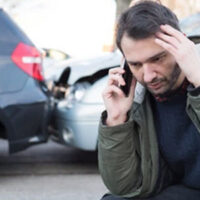Liability In Chain Reaction Accidents

Determining fault after a car accident can sometimes be challenging, especially when it comes to chain reaction accidents. This is because, in a chain reaction collision, multiple vehicles and drivers are involved. If you were involved in a chain reaction accident, you should contact a skilled car accident attorney who can help you determine who caused your accident and obtain the compensation you deserve. Just because determining fault after a chain-reaction collision can be challenging doesn’t mean it is impossible.
What Is a Chain Reaction Collision?
A chain reaction accident is a type of accident involving at least three vehicles in a row. This type of accident happens when cars hit one another in a series of rear-end collisions. Often, chain reaction collisions occur during traffic stops or on narrow roads. Below is a typical example of a chain collision accident;
Driver 1 -> Driver 2 -> Driver 3 -> Driver 4
Driver 3 rear-ends Driver 4, and because Driver 2 was following Driver 3 too closely and could not stop their vehicle on time, Driver 2 also rear-ends Driver 3. Because Driver 1 could also not stop on time, they hit Driver 2 from the back. Now, because of the collision between Driver 3 and Driver 4, the chain will continue if Driver 3 sends Driver 4’s vehicle forward into another car, and so on.
From the above example, you can see that a chain-reaction accident case can involve multiple drivers who acted negligently. Because of that handling, a chain reaction accident claim can be challenging.
Determining Liability in a Chain Reaction Accident
In a typical chain-reaction collision, the driver who caused the first crash may likely be held liable for the accident. But, as you can see from the above example, other parties may share blame as well. When it comes to determining liability in a chain reaction collision, the key is proving negligence on the part of any party you believe played a role in causing the accident. Some of the common negligent actions that lead to chain reaction collisions include;
- Tailgating
- Speeding
- Distracted driving
- Failure to use brake lights or other signals
- Failure to yield the right of way
An issue that usually comes into play in most chain reaction collisions is tailgating. In Florida, drivers are not allowed to follow other drivers more closely than is reasonable and prudent. Any driver who tailgates will almost always be considered negligent.
Sources that can help you establish fault after a chain-reaction collision include;
- Witness statements
- Police reports
- Evidence gathered at the accident scene, including vehicle debris
- Record of traffic violation
- Surveillance cameras
Comparative Negligence Laws in Florida
It is common for more than one driver to be at fault for a chain-reaction collision. If more than one driver is liable for the chain reaction collision that led to your injury, then all the at-fault drivers will share fault for the accident, and each driver will pay you according to their percentage of fault.
Suppose you were injured in a chain-reaction collision, and it is determined that your own fault contributed to the accident. Fortunately, you can still obtain compensation in such a case. However, the amount of compensation you receive in such a situation will be reduced by your percentage of fault.
Contact a Coral Springs Car Accident Lawyer
If you or someone you know has been involved in a chain reaction collision in Florida, contact a Coral Springs car accident lawyer at Lyons & Snyder to schedule a consultation.
Resource:
